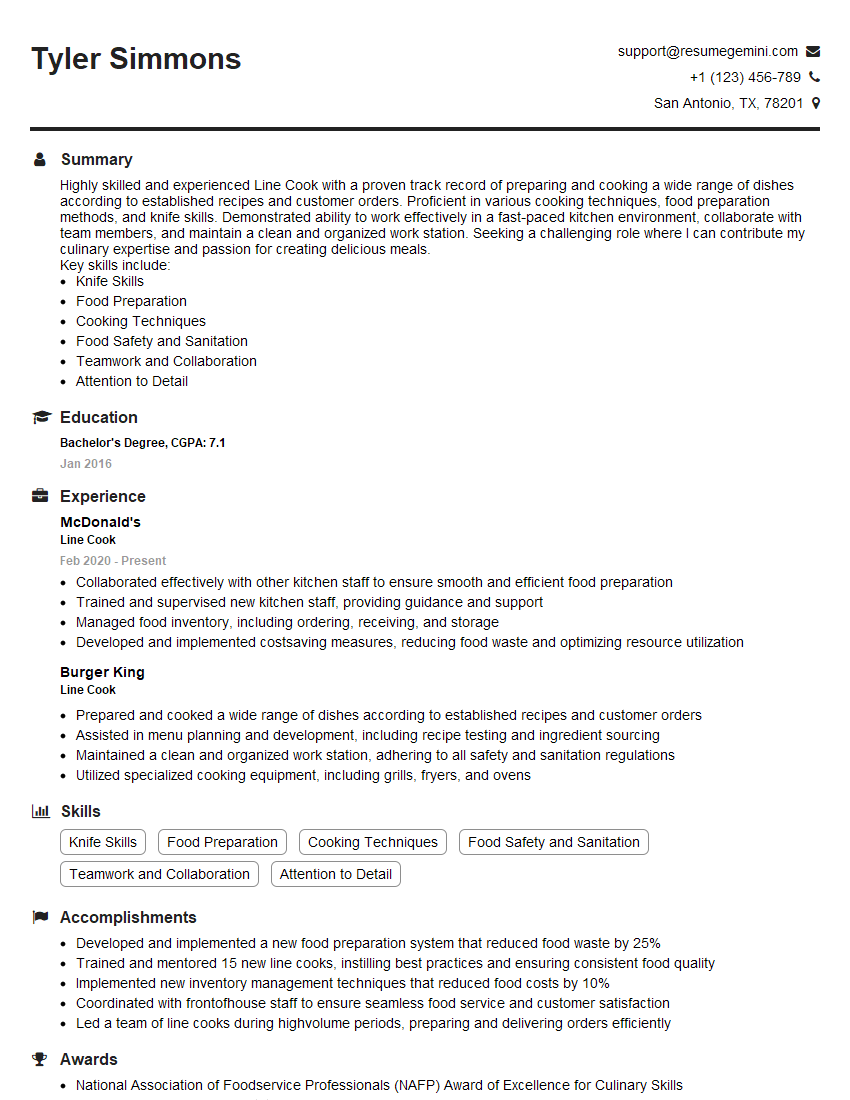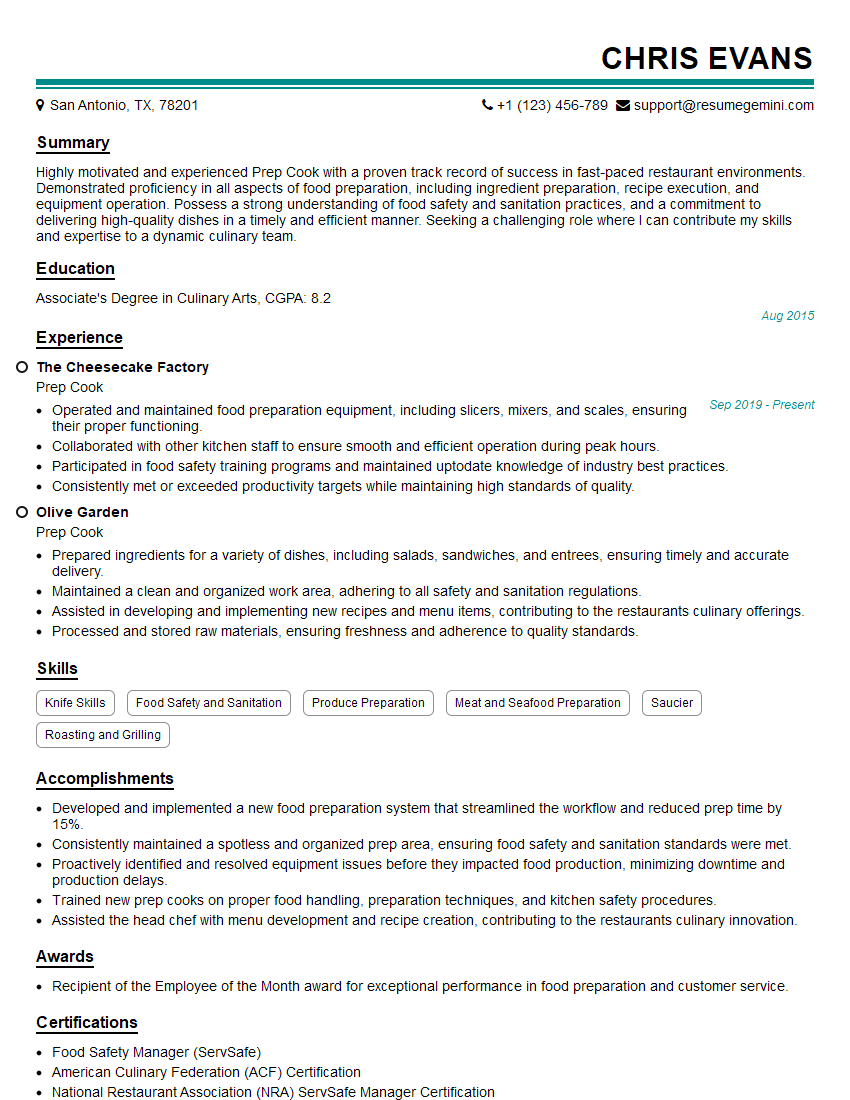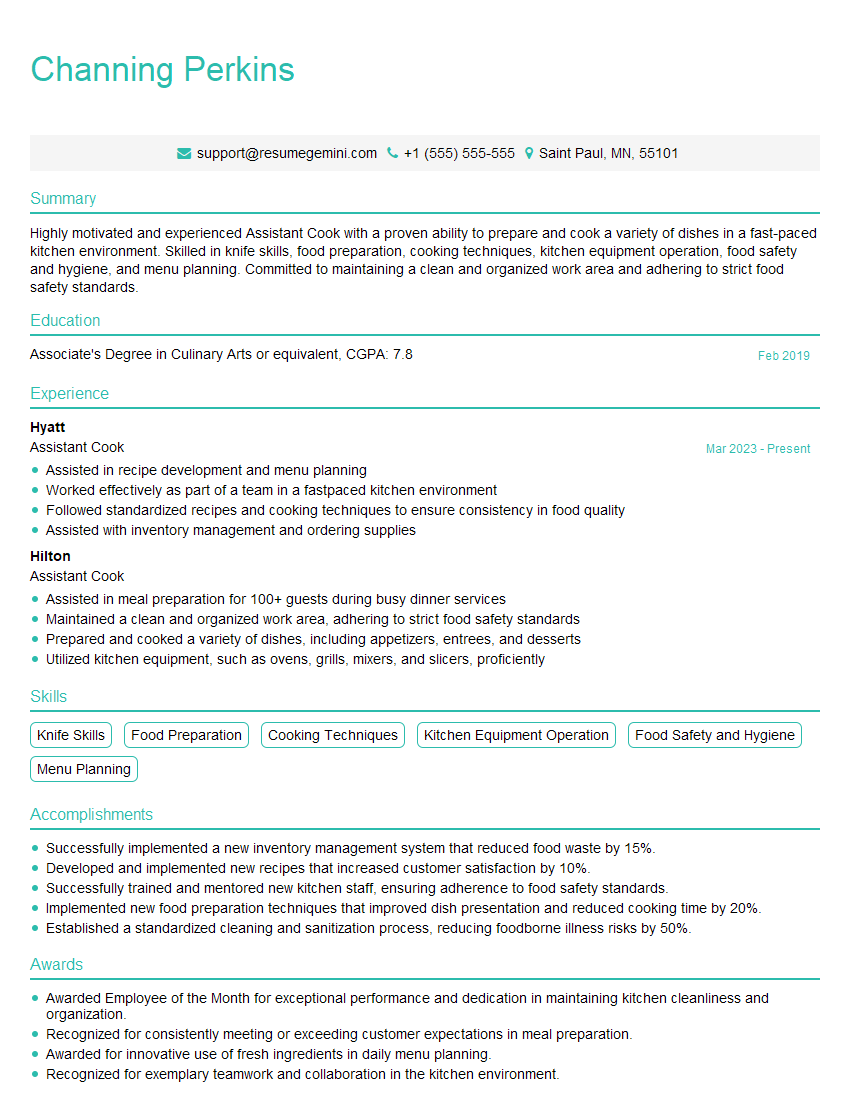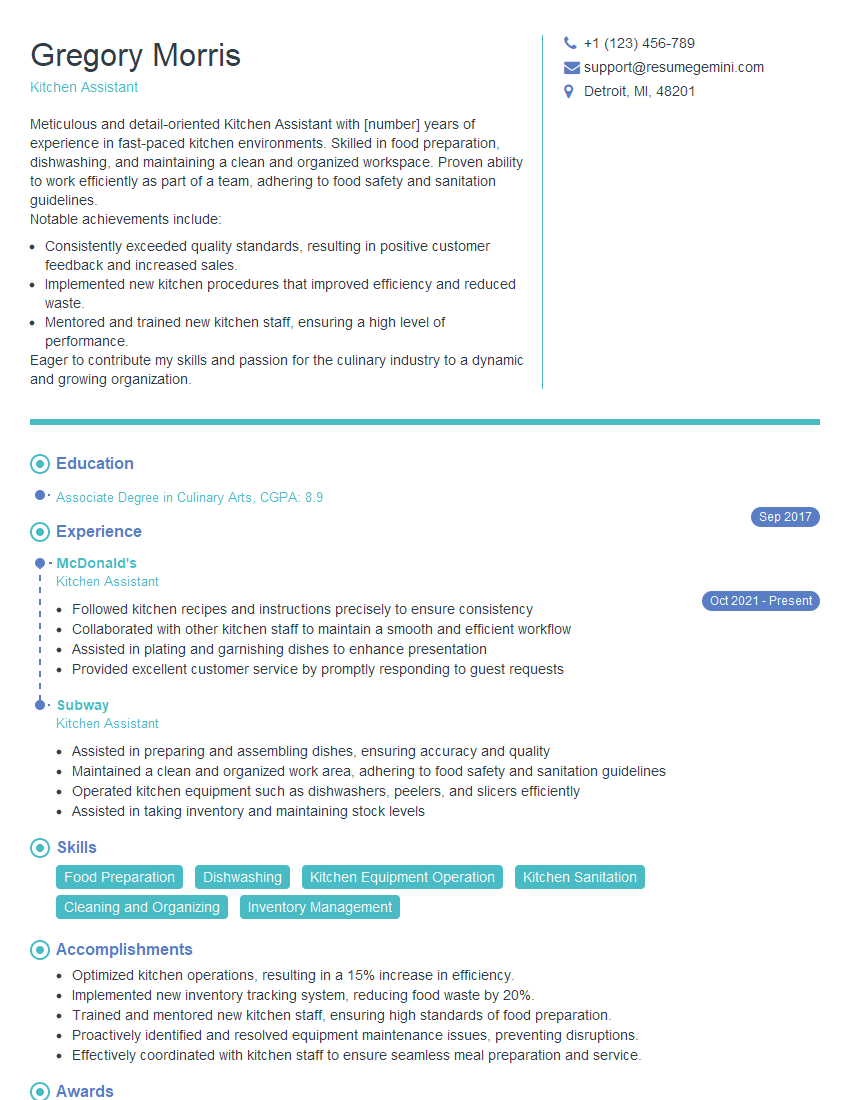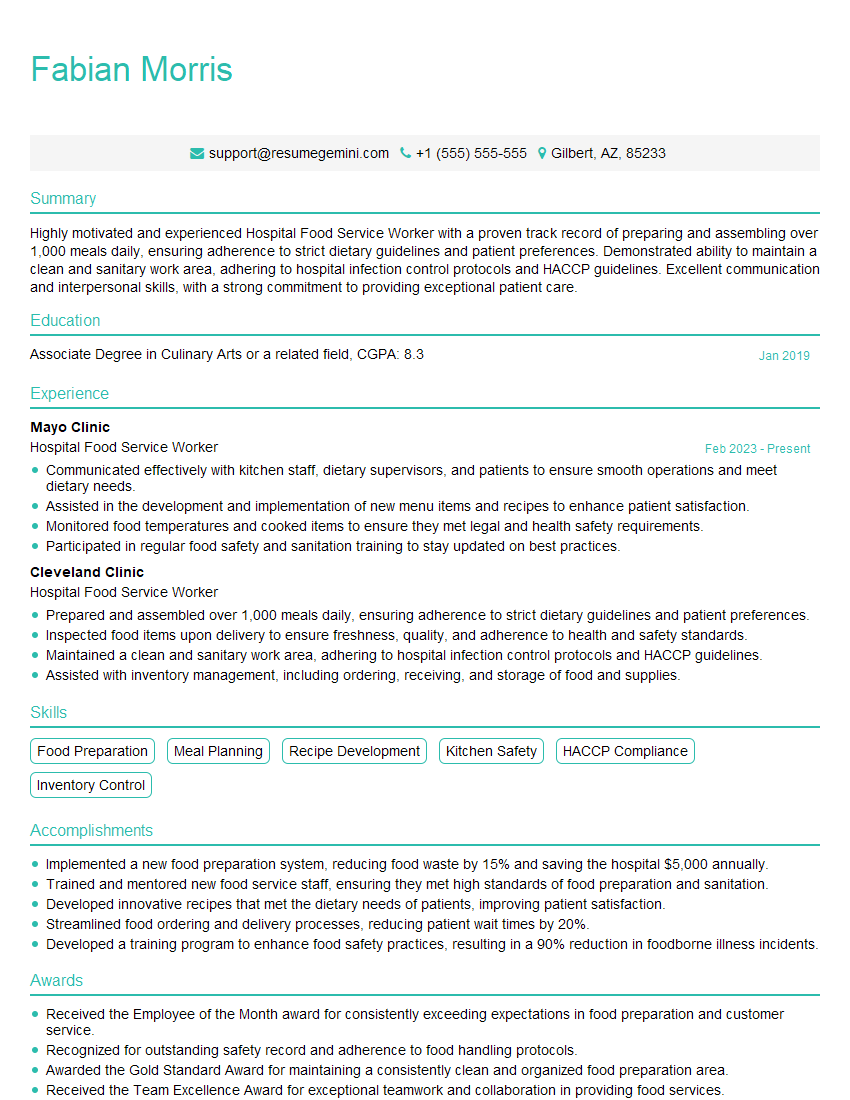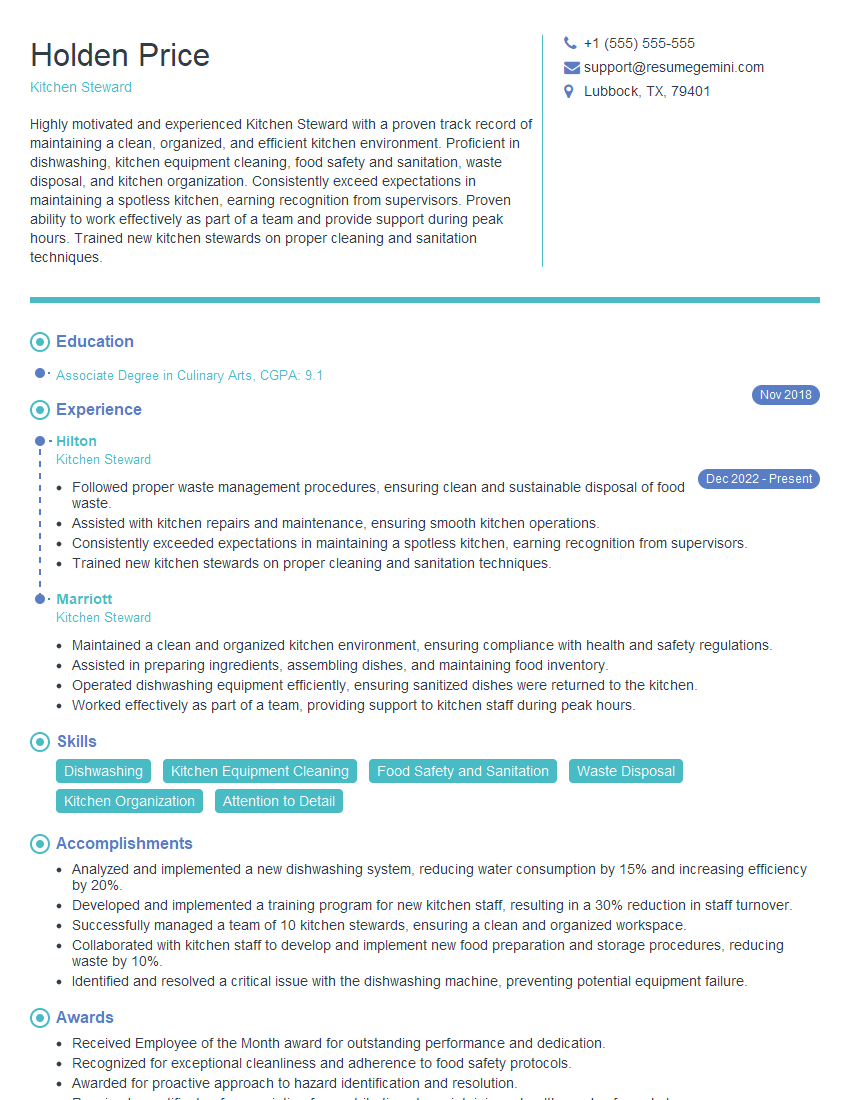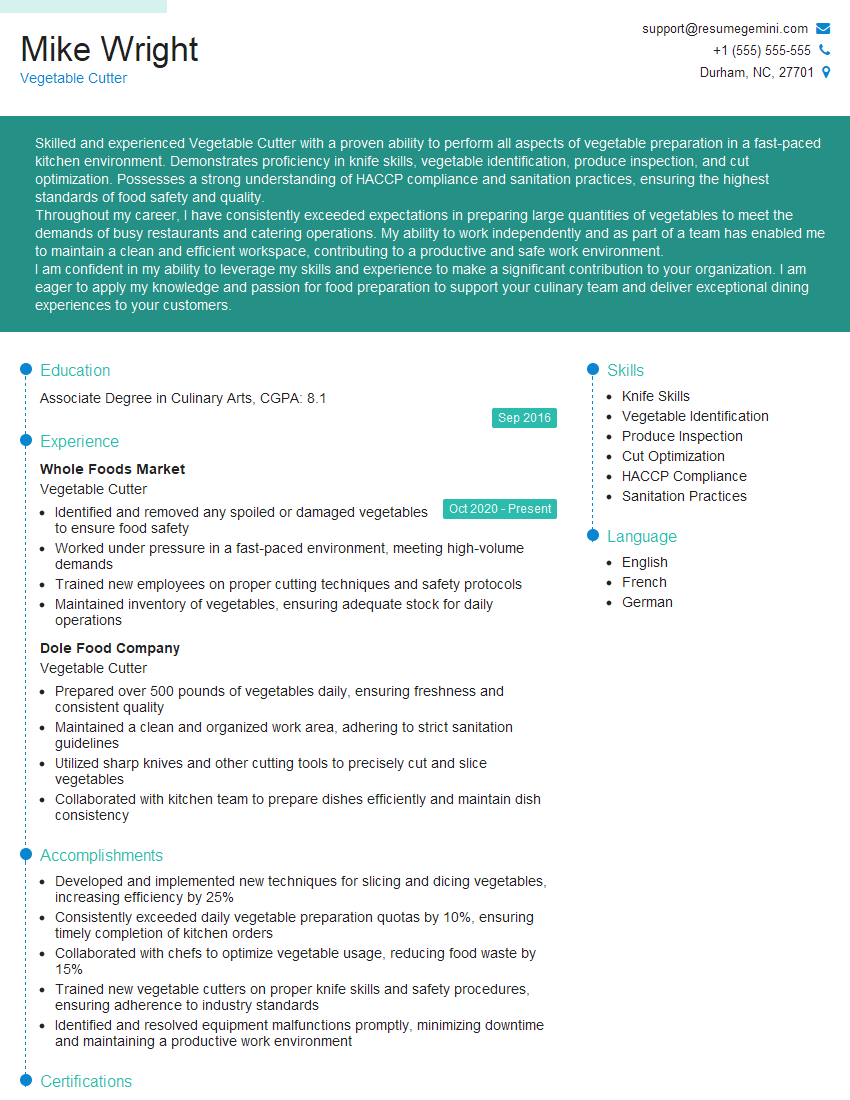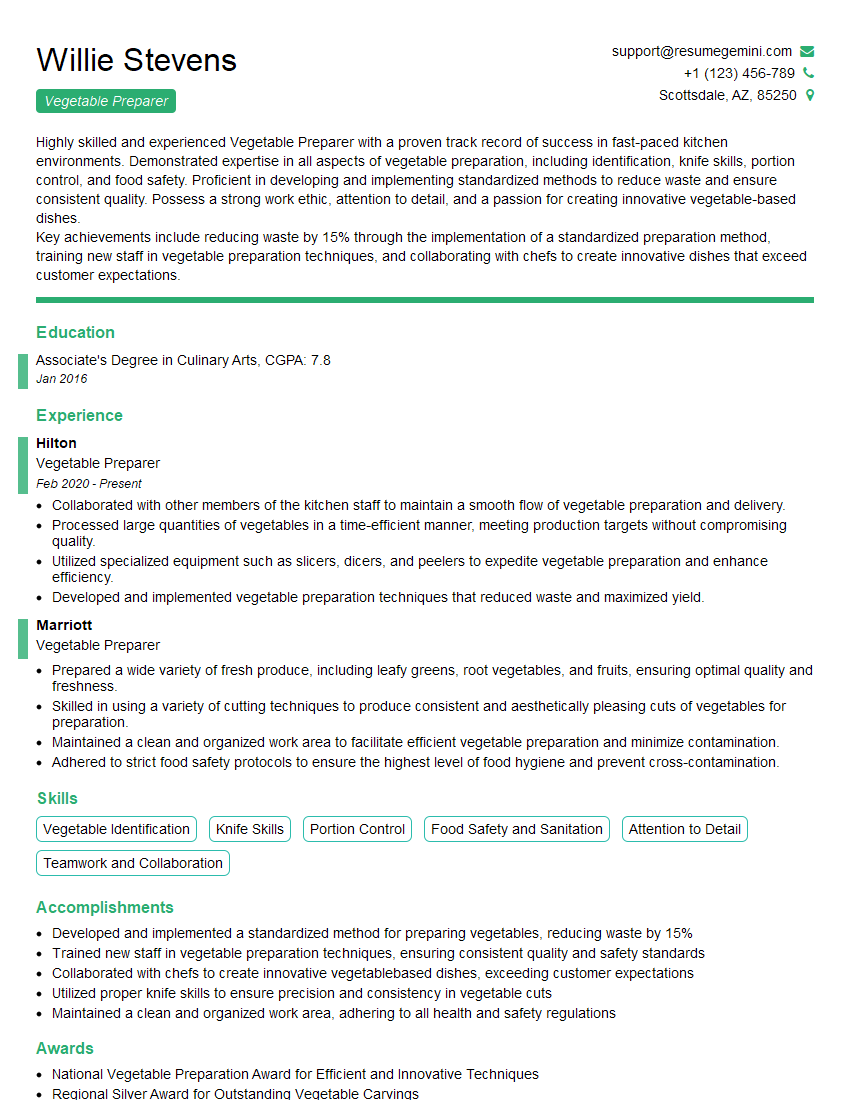Interviews are more than just a Q&A session—they’re a chance to prove your worth. This blog dives into essential Vegetable Preparation interview questions and expert tips to help you align your answers with what hiring managers are looking for. Start preparing to shine!
Questions Asked in Vegetable Preparation Interview
Q 1. What are the proper methods for washing and sanitizing different types of vegetables?
Washing and sanitizing vegetables is crucial for food safety. The process varies slightly depending on the vegetable type, but the core principles remain the same: thorough cleaning and effective sanitization to eliminate harmful bacteria and pathogens.
- Leafy Greens: Start by removing any outer, damaged leaves. Then, gently wash under cool running water, separating leaves to remove any trapped soil or debris. A quick soak in a bowl of cold water with a splash of white vinegar can help loosen stubborn dirt. Finally, rinse thoroughly again.
- Root Vegetables (carrots, potatoes, etc.): Scrub the vegetables firmly with a vegetable brush under cool running water to remove soil. Pay close attention to crevices and irregularities on the surface. A final rinse ensures all loose dirt is gone.
- Fruits and Vegetables with Skins (e.g., peppers, cucumbers): Wash these thoroughly under running water, scrubbing with a brush if necessary. For delicate skins, avoid harsh scrubbing.
- Sanitization: After washing, a sanitizing step is beneficial, especially for produce that will be consumed raw. A simple solution of 1 teaspoon of unscented household bleach per gallon of water is effective. Submerge the washed vegetables for 2 minutes, then rinse thoroughly with clean water. Alternatively, you can use a commercial food-grade sanitizer according to the manufacturer’s instructions.
Practical Application: In a restaurant kitchen, a three-compartment sink is often used for washing vegetables. The first compartment holds the wash water, the second compartment contains the sanitizing solution, and the third contains clean water for rinsing.
Q 2. Explain the different knife cuts used in vegetable preparation (e.g., dice, julienne, brunoise).
Knife cuts are fundamental in vegetable preparation, impacting both the appearance and cooking time of dishes. Mastering these techniques enhances efficiency and consistency.
- Dice: A small, uniformly sized cube. Common sizes include small dice (1/8 inch), medium dice (1/4 inch), and large dice (1/2 inch).
- Julienne: Long, thin strips, typically 1/8 inch x 1/8 inch x 2-3 inches. Think matchsticks.
- Brunoise: The smallest dice cut, measuring 1/16 inch x 1/16 inch x 1/16 inch. Requires sharp knives and precise technique.
- Mincing: Finely chopping into irregular, small pieces.
- Chiffonade: Used for leafy herbs or vegetables. Roll the leaves tightly, then slice thinly across the roll to create ribbons.
Example: Imagine preparing a mirepoix (a base for many sauces). You would typically dice onions, carrots, and celery into a consistent size (usually medium dice) to ensure even cooking.
Q 3. How do you ensure the proper yield and minimize waste during vegetable preparation?
Maximizing yield and minimizing waste are crucial for both cost-effectiveness and sustainability. Careful planning and techniques can drastically reduce waste.
- Proper Peeling and Trimming: Use a sharp peeler to remove only the necessary amount of skin. Avoid excessive trimming unless required for recipe specifications. Consider using vegetable peelers with adjustable blade settings to achieve optimal results.
- Creative Use of Scraps: Vegetable scraps (onion ends, carrot peels) can be used to make stocks or added to soups. This reduces waste and adds flavor.
- Careful Portioning: Estimate vegetable needs carefully and portion accurately. Use precise measurements to reduce excess prep work.
- Storage Optimization: Store vegetables properly to maintain freshness and reduce spoilage (discussed in more detail in a later answer). First In, First Out (FIFO) rotation is key.
Example: Instead of discarding carrot tops, you can finely chop them and add them to a salad for a fresh, peppery flavor.
Q 4. Describe your experience with various vegetable preparation tools and equipment.
My experience encompasses a wide range of vegetable preparation tools and equipment, from basic knives to specialized machines.
- Knives: I’m proficient with various knife types, including chef’s knives, paring knives, serrated knives, and boning knives. Proper knife handling and maintenance are essential for safety and efficiency.
- Cutting Boards: I understand the importance of using different cutting boards for different food types to prevent cross-contamination. Properly sanitizing the boards after each use is crucial.
- Mandolines: These are invaluable for creating uniform slices and cuts, especially for vegetables like zucchini or potatoes.
- Food Processors: These can significantly speed up tasks like chopping, dicing, and pureeing, increasing efficiency in high-volume settings.
- Vegetable Peelers: I prefer those with sharp, adjustable blades for precision peeling.
Practical Application: In a large-scale kitchen, understanding the capabilities of commercial food processors and the importance of proper knife maintenance can significantly impact productivity and reduce the risk of injury.
Q 5. How do you identify and handle spoiled or damaged vegetables?
Identifying and handling spoiled or damaged vegetables is paramount for food safety and quality control.
- Visual Inspection: Look for signs of discoloration, bruising, wilting, mold growth, or unusual spots. Smell the vegetables; off-odors are often a sign of spoilage.
- Texture Check: Feel the vegetable; mushy or unusually soft textures are indicators of spoilage.
- Discarding Spoiled Produce: Immediately discard any vegetables showing signs of spoilage. Don’t try to salvage them; the risks outweigh the benefits.
- Prevention: Proper storage and handling (discussed in next answer) are crucial for preventing spoilage.
Example: A brown spot on a potato that is accompanied by a soft, mushy texture is an obvious sign of spoilage. The potato should be immediately discarded.
Q 6. What are the best practices for storing different types of vegetables to maintain freshness?
Proper storage is critical for maintaining vegetable freshness and extending their shelf life.
- Refrigeration: Most vegetables should be refrigerated. Leafy greens benefit from being stored in perforated plastic bags to maintain air circulation. Root vegetables are often best stored in a cool, dark, and dry place, not necessarily in the refrigerator.
- Humidity: Some vegetables (like leafy greens) require higher humidity, while others (like root vegetables) prefer lower humidity. Using appropriate containers and plastic bags can help manage humidity levels.
- Freezing: Many vegetables can be frozen to preserve them for longer periods. Blanching (briefly boiling or steaming) vegetables before freezing helps maintain color, texture, and nutrient content.
- Avoid Overcrowding: Make sure there’s enough air circulation around the vegetables to prevent moisture buildup, which can lead to decay.
Example: Storing asparagus upright in a glass of water in the refrigerator, keeping the cut ends submerged, helps maintain crispness.
Q 7. Explain the importance of proper temperature control during vegetable preparation.
Temperature control is crucial throughout the vegetable preparation process. It impacts both food safety and the quality of the final product.
- Preventing Bacterial Growth: Keeping vegetables at safe temperatures (below 40°F (4°C) or above 140°F (60°C)) minimizes the risk of bacterial growth.
- Maintaining Quality: Rapid cooling after cooking is crucial for preserving color, texture, and nutrients. Using an ice bath to stop the cooking process is effective.
- Avoiding Enzymatic Browning: Some vegetables (like apples and potatoes) undergo enzymatic browning when exposed to air. Acidic ingredients (like lemon juice) can help slow down this process.
- Consistent Cooking: Maintaining appropriate cooking temperatures ensures even cooking and prevents overcooking, which can lead to mushy textures.
Example: When preparing a large batch of green beans for a catering event, rapid chilling using ice water after blanching is essential to preserve the vibrancy and texture.
Q 8. How do you ensure food safety and hygiene standards are met during vegetable preparation?
Food safety and hygiene are paramount in vegetable preparation. It’s not just about preventing illness; it’s about maintaining the integrity and quality of the food. My approach is multifaceted and begins even before the vegetables arrive.
- Source Inspection: I meticulously check all incoming produce for freshness, bruises, and signs of spoilage. Rejecting substandard produce is the first line of defense.
- Handwashing: Frequent handwashing is crucial, especially after handling raw vegetables or anything else that could contaminate surfaces. I use warm water and soap, scrubbing for at least 20 seconds. Hand sanitizer is used between handwashes when appropriate.
- Proper Cleaning Techniques: Vegetables are thoroughly washed under running cold water to remove dirt, pesticides, and other debris. For leafy greens, I often use a vegetable wash to ensure complete cleansing. Some vegetables benefit from scrubbing with a brush.
- Temperature Control: Maintaining the proper cold chain is vital. Vegetables should be stored at appropriate temperatures to prevent bacterial growth. This includes using refrigerated storage and minimizing the time vegetables spend at room temperature.
- Cross-Contamination Prevention: I use separate cutting boards and knives for raw and cooked vegetables to prevent cross-contamination. Surfaces are sanitized regularly. Ready-to-eat vegetables are kept completely separate from raw vegetables.
- Waste Management: Proper disposal of food waste is crucial to avoid attracting pests and maintaining a clean workspace. We use clearly labeled bins for different waste streams.
Think of it like this: every step is a link in a chain. If one link is weak, the entire process is compromised. Consistent attention to detail is key.
Q 9. Describe your experience with standardized recipes and portion control in vegetable preparation.
Standardized recipes and portion control are essential for consistency and efficiency, especially in a high-volume kitchen. I have extensive experience working with both, ensuring both quality and cost-effectiveness.
- Recipe Adherence: I meticulously follow standardized recipes, ensuring precise measurements and cooking times. This maintains consistency in taste, texture, and appearance across all servings.
- Portion Control Methods: I employ various portion control methods, including using standardized scoops, weighing portions, and utilizing pre-portioned containers. This ensures consistent portion sizes and minimizes waste.
- Yield Management: I’m adept at calculating the required quantities of vegetables based on projected demand, considering factors like portion sizes, wastage, and potential leftovers. This prevents both shortages and excess.
- Inventory Management: Working with standardized recipes supports inventory management. By knowing the exact quantity of ingredients needed, we can minimize spoilage and optimize purchasing decisions.
For example, in a previous role, we standardized our recipe for roasted vegetables, specifying the exact weight of each vegetable, the roasting temperature, and the cooking time. This led to a significant improvement in quality consistency and reduced food waste.
Q 10. How do you manage your time efficiently during peak hours of vegetable preparation?
Peak hours demand meticulous time management. My approach involves a combination of planning, organization, and prioritization.
- Mise en Place: Before the rush begins, I meticulously prepare all ingredients – a technique known as ‘mise en place.’ This involves washing, peeling, chopping, and measuring everything in advance. It’s like setting the stage for a performance. Everything is ready to go when needed.
- Task Prioritization: I prioritize tasks based on urgency and timing. Items needed earlier in the service period are tackled first.
- Teamwork: Effective teamwork is crucial. Clear communication and delegation ensure smooth workflow. If I see a colleague struggling, I assist; if I need help, I ask for it.
- Workflow Optimization: I constantly analyze workflows to identify bottlenecks and improve efficiency. This might involve rearranging equipment, adjusting preparation steps, or streamlining processes.
Imagine a well-oiled machine. Every part works seamlessly, and there’s no wasted motion. This is my goal during peak periods.
Q 11. How do you handle large quantities of vegetables during busy service periods?
Handling large quantities of vegetables during busy periods requires efficient systems and teamwork. My experience involves:
- Batch Processing: I break down large tasks into smaller, manageable batches. This prevents overwhelming the workspace and makes the process more efficient.
- Equipment Utilization: Utilizing time-saving equipment such as food processors and commercial slicers significantly increases speed and efficiency, especially during peak periods.
- Strategic Storage: Organizing vegetable storage for easy access to frequently used items during rush hours is critical. We use clear containers and strategic placement to minimize search time.
- Team Collaboration: A well-coordinated team is essential. Each member has assigned tasks and responsibilities, creating a smooth workflow.
For instance, during a large catering event, I coordinated a team to prep hundreds of pounds of vegetables for a variety of dishes. We used batch processing and teamwork to ensure everything was ready on time.
Q 12. Describe your experience with different cooking methods that involve prepared vegetables.
My experience spans various cooking methods involving prepared vegetables:
- Roasting: Roasting enhances the natural sweetness of vegetables and adds depth of flavor. I’m experienced in roasting a wide variety of vegetables, from simple root vegetables to more complex combinations.
- Sautéing: Sautéing quickly cooks vegetables, preserving their texture and vibrant color. This method is particularly useful for delicate vegetables.
- Steaming: Steaming is a healthy method that retains nutrients and moisture. I am adept at steaming vegetables to achieve varying levels of tenderness.
- Blanching: Blanching involves briefly cooking vegetables in boiling water, then shocking them in ice water to stop the cooking process. It’s ideal for preserving color and texture.
- Stir-frying: Stir-frying is a quick, high-heat cooking method that requires precise timing and technique. I’m skilled in stir-frying vegetables to maintain their crispness and flavor.
Each method requires a nuanced understanding of heat control, timing, and the properties of different vegetables. My experience allows me to adapt to various situations and create a range of flavors and textures.
Q 13. How do you maintain consistency in the quality and appearance of prepared vegetables?
Maintaining consistency in the quality and appearance of prepared vegetables requires attention to detail throughout the entire process.
- Uniformity in Cutting: Using standardized cutting techniques ensures consistent sizes and shapes, improving both the visual appeal and cooking time uniformity.
- Careful Handling: Gentle handling prevents bruising and damage, preserving the quality and appearance of the vegetables.
- Consistent Cooking Methods: Adhering to standardized recipes and cooking methods guarantees consistent results in terms of texture, color, and flavor.
- Quality Control Checks: Regular quality checks throughout the preparation process identify and correct inconsistencies before they become major issues.
Imagine a plate of roasted vegetables: uniformly sized pieces, evenly cooked, and vibrant in color. This is the result of consistent application of these principles.
Q 14. What are the common challenges in vegetable preparation and how do you overcome them?
Common challenges in vegetable preparation include:
- Seasonal Variation: Vegetable quality and availability vary seasonally, requiring adjustments in recipes and sourcing strategies.
- Waste Management: Minimizing waste is an ongoing challenge, requiring careful planning, portion control, and creative reuse of vegetable scraps.
- Maintaining Freshness: Preserving the freshness and quality of vegetables during storage and preparation is crucial.
- Consistency in Preparation: Maintaining consistent quality and presentation across large batches requires attention to detail and standardization.
To overcome these challenges, I utilize strategies like careful sourcing, precise recipe adherence, waste reduction initiatives, and team training on proper handling techniques. Adaptability and problem-solving are essential in this dynamic field.
Q 15. How do you work effectively as part of a kitchen team during vegetable preparation?
Effective teamwork in a kitchen hinges on communication, efficiency, and a shared understanding of the task at hand. During vegetable preparation, this translates to clear task assignments, maintaining a clean and organized work station, and proactively assisting colleagues where needed. For instance, if one chef is prepping onions for a large order, another might simultaneously wash and chop other vegetables, optimizing workflow. We regularly use mise en place, a French term meaning “everything in its place,” to ensure all ingredients are prepped and ready before cooking begins. This organized approach drastically improves efficiency and reduces stress during the service rush. A strong team also proactively communicates about ingredient quantities and potential shortages to avoid delays. It’s about synchronicity: a well-oiled machine where individual contributions seamlessly mesh to achieve a common culinary goal.
Career Expert Tips:
- Ace those interviews! Prepare effectively by reviewing the Top 50 Most Common Interview Questions on ResumeGemini.
- Navigate your job search with confidence! Explore a wide range of Career Tips on ResumeGemini. Learn about common challenges and recommendations to overcome them.
- Craft the perfect resume! Master the Art of Resume Writing with ResumeGemini’s guide. Showcase your unique qualifications and achievements effectively.
- Don’t miss out on holiday savings! Build your dream resume with ResumeGemini’s ATS optimized templates.
Q 16. Describe your experience with vegetable peeling, trimming, and coring techniques.
My experience with vegetable peeling, trimming, and coring spans years, encompassing a wide range of techniques honed through practice and culinary training. Peeling techniques vary depending on the vegetable—for potatoes, I utilize a peeler for efficiency and a consistent thickness, whereas for delicate vegetables like carrots, I use a paring knife for precision. Trimming requires an understanding of each vegetable’s structure; for example, I carefully remove the tough ends of green beans, ensuring uniformity and optimizing texture. Coring is crucial for vegetables like peppers and apples; I use a small, sharp knife to efficiently remove the core, ensuring minimal waste and preparing the vegetable for various cooking applications. I also employ specialized tools like a corer for apples or tomatoes, where appropriate. Safety is paramount; I always use sharp knives to minimize the effort and risk of accidental slips or cuts. Sharp knives are far safer than dull ones.
Q 17. How do you identify and utilize different types of vegetables for specific dishes?
Identifying and utilizing vegetables for specific dishes requires a deep understanding of their flavor profiles, textures, and cooking properties. For example, the sweetness of butternut squash complements the richness of a curry, while the crispness of bell peppers adds a vibrant texture to stir-fries. The earthy flavor of mushrooms pairs well with beef, whereas the delicate flavor of asparagus shines in lighter dishes. I consider factors like the desired texture (e.g., creamy mashed potatoes versus crispy roasted broccoli), the dish’s overall flavor profile, and the cooking method when selecting vegetables. I also take into account seasonal availability to maintain the highest quality and freshness.
For instance, in creating a Mediterranean salad, I’d choose ripe tomatoes for their sweetness and juicy texture, crisp cucumbers for their refreshing crunch, and Kalamata olives for their salty, briny flavor. The selection process involves both sensory appreciation and culinary knowledge, ensuring a harmonious and flavorful end product.
Q 18. Explain the importance of understanding vegetable seasonality in preparation.
Understanding vegetable seasonality is critical for optimal flavor, texture, and cost-effectiveness. Seasonal vegetables are at their peak ripeness during their natural growing season; this translates to superior taste and nutritional value. In-season vegetables are also typically more affordable because of increased availability. Choosing seasonal produce showcases respect for the environment and supports local farmers. Conversely, out-of-season vegetables often require extensive transportation, resulting in a higher carbon footprint and potentially reduced quality. For example, using ripe, in-season tomatoes in a summer salsa elevates its flavor profile compared to using imported tomatoes in winter.
Q 19. How do you adapt your vegetable preparation techniques to different culinary styles?
Adapting vegetable preparation techniques to different culinary styles is a key aspect of culinary versatility. For example, preparing vegetables for a French dish might involve precise cuts like julienne or brunoise for elegant presentations. In contrast, Italian cuisine often embraces rustic techniques like roughly chopping vegetables for hearty stews or pasta sauces. Asian cuisine often calls for different techniques such as finely slicing vegetables for stir-fries or creating intricate garnishes. Knowing these styles allows me to tailor my approach to complement the unique characteristics of each cuisine, enhancing the final presentation and dining experience.
Q 20. What are the best practices for preparing vegetables for different cooking applications (e.g., roasting, steaming, sautéing)?
Vegetable preparation for different cooking methods requires specific techniques to optimize the final result. For roasting, vegetables should be cut into relatively uniform sizes to ensure even cooking; adding a touch of oil and seasoning enhances flavor and browning. Steaming preserves nutrients and texture; vegetables should be cut into smaller pieces for faster and more even cooking. Sautéing requires quick cooking; vegetables are typically cut into small, bite-sized pieces and cooked in a hot pan with a small amount of oil. Understanding these nuances allows for tailored preparation that maximizes flavor and texture across different cooking styles.
Q 21. How do you maintain knife sharpness and safety when preparing vegetables?
Maintaining knife sharpness is essential for both safety and efficiency. A sharp knife requires less force, reducing the risk of accidental slips and cuts. I regularly hone my knives using a honing steel between uses to maintain their edge. I also have my knives professionally sharpened periodically to ensure optimal performance. Proper knife handling is equally important; always cut away from yourself, use a stable cutting board, and keep your fingers curled away from the blade. These practices minimize risks and promote a safe and productive work environment. Regular cleaning and proper storage also contributes to the longevity and safety of the knives.
Q 22. How do you handle different textures and densities of vegetables during preparation?
Handling vegetables with varying textures and densities requires a nuanced approach. Think of it like cooking a symphony – each instrument (vegetable) needs its own attention to shine. For instance, delicate greens like spinach wilt quickly, needing minimal handling and gentle washing. Conversely, root vegetables like carrots and potatoes require more robust preparation, potentially involving peeling, chopping, and even pre-cooking techniques to achieve even texture and optimal cooking time. I always tailor my approach to the specific vegetable’s characteristics. For example, when preparing a dish with both asparagus and potatoes, I would blanch the asparagus spears briefly to retain their bright green color and crisp texture, while the potatoes would need longer cooking time, possibly even pre-roasting, depending on the final dish.
- Delicate Vegetables: Spinach, lettuce, herbs – gentle washing, minimal chopping.
- Medium-Density Vegetables: Bell peppers, zucchini – medium chopping, quicker cooking times.
- Dense Vegetables: Carrots, potatoes, root vegetables – peeling, chopping into uniform sizes for even cooking.
Q 23. Describe your experience with blanching, shocking, and other pre-cooking vegetable techniques.
Blanching, shocking, and other pre-cooking techniques are crucial for preserving color, texture, and nutrients. Blanching, which involves briefly plunging vegetables into boiling water, then immediately transferring them to an ice bath (shocking), is my go-to method for many vegetables. It inactivates enzymes that cause loss of color and nutrients while also softening the vegetables for easier cooking. For example, I often blanch broccoli florets before roasting to prevent them from becoming mushy while still achieving a tender-crisp texture. Other pre-cooking methods include steaming, which is gentle and retains more nutrients, or parboiling, useful for vegetables like potatoes, which need to be cooked partly before adding them to other dishes. These methods also allow for even cooking, as they bring the vegetables to a uniform temperature before the final cooking stage.
Q 24. How do you ensure the even cooking of vegetables, regardless of size and shape?
Achieving even cooking across different vegetable sizes and shapes is all about precision and preparation. The key is uniformity. I always aim for consistent size and shape – think uniform dice, slices, or sticks. This ensures that heat distributes evenly, preventing some pieces from overcooking while others remain undercooked. For instance, when roasting vegetables, I aim to cut all pieces to roughly the same size. I also utilize appropriate cooking techniques. For instance, if I have vegetables of varying thicknesses, I may parboil the thicker ones slightly before adding them to the main dish to ensure that they’re tender by the time the thinner pieces are perfectly cooked.
- Uniform Sizing: Consistent pieces ensure even cooking.
- Pre-cooking: Parboiling or blanching thick pieces helps them catch up.
- Proper Cooking Method: Roasting works well for uniform pieces, whereas steaming is effective for diverse shapes.
Q 25. What are your strategies for minimizing oxidation in prepared vegetables?
Minimizing oxidation, that browning you see on cut fruits and vegetables, is critical for preserving both appearance and flavor. Oxidation occurs when vegetables are exposed to air, so I employ several strategies. One effective method is to immediately submerge cut vegetables in acidulated water (water with a squeeze of lemon juice or vinegar). The acid helps prevent enzymatic browning. Another strategy is to store cut vegetables in airtight containers, refrigerated, to minimize contact with air. Also, blanching vegetables helps deactivate enzymes that cause oxidation. For example, I always add a little lemon juice to the water when blanching potatoes to maintain their bright white color.
Q 26. How do you handle vegetable waste responsibly and sustainably?
Responsible and sustainable vegetable waste management is a core value in my practice. I always strive to minimize waste from the start by carefully planning recipes and using appropriate portion sizes. Composting is a vital part of my strategy. Vegetable scraps, peels, and other trimmings are composted to enrich the soil, reducing landfill waste and creating nutrient-rich fertilizer. Additionally, I frequently find creative ways to utilize vegetable scraps in stocks or sauces, transforming waste into flavorful additions to other dishes. For example, vegetable scraps can be used to create a rich vegetable broth, minimizing waste and maximizing flavor.
Q 27. Describe your experience with using various herbs and spices to enhance the flavor of prepared vegetables.
Herbs and spices are my secret weapons for elevating the flavor of vegetables. I view them not just as seasonings but as integral components of the dish. For example, roasting root vegetables with rosemary and thyme adds a beautiful earthy aroma and complexity. Similarly, using fresh cilantro with corn enhances its sweetness and adds a vibrant freshness. I carefully consider the flavor profiles of vegetables when selecting herbs and spices. Subtle flavors like chives and dill work well with delicate vegetables, whereas bolder spices like cumin and paprika complement more robust vegetables. I also experiment with different spice combinations to create unique and exciting flavor profiles.
Q 28. How do you adjust your vegetable preparation techniques based on customer preferences or dietary restrictions?
Adaptability is key. I always consult with customers regarding their preferences and dietary restrictions before preparing vegetables. For example, if a customer has a gluten allergy, I ensure that any sauces or seasonings used are gluten-free. Similarly, if someone is vegan, I avoid any animal products. I offer substitutions or modifications to recipes to cater to various dietary requirements and preferences – perhaps using different oils or cooking methods, or adjusting spice levels according to customer taste. This flexibility ensures that every customer receives a tailored and enjoyable experience.
Key Topics to Learn for Vegetable Preparation Interview
- Knife Skills: Mastering basic cuts (dicing, mincing, julienning, brunoise) and their applications in different dishes. Understanding the importance of safety and efficiency in knife handling.
- Vegetable Identification and Selection: Recognizing seasonal vegetables, understanding quality indicators (e.g., firmness, color), and selecting appropriate produce for various recipes. Knowing the differences in taste and texture among varieties.
- Preparation Techniques: Proficiency in peeling, trimming, cleaning, and blanching various vegetables. Understanding the impact of different preparation methods on texture, flavor, and nutrient retention.
- Food Safety and Hygiene: Adhering to proper sanitation practices, including handwashing, cross-contamination prevention, and safe storage techniques. Understanding the importance of temperature control to prevent spoilage.
- Yield and Waste Reduction: Efficiently utilizing whole vegetables to minimize waste. Implementing strategies for maximizing yield and portion control.
- Understanding Recipe Requirements: Interpreting recipes accurately and adapting preparation techniques to meet specific recipe demands (e.g., uniform size for even cooking).
- Equipment Knowledge: Familiarity with common kitchen equipment used in vegetable preparation (e.g., mandolines, food processors, peelers). Understanding the proper use and maintenance of this equipment.
- Working Efficiently and as Part of a Team: Demonstrating organizational skills, time management, and the ability to collaborate effectively with other kitchen staff.
Next Steps
Mastering vegetable preparation is crucial for advancement in any culinary role, opening doors to more challenging and rewarding positions. A well-crafted resume is key to showcasing your skills and experience effectively to potential employers. Building an ATS-friendly resume increases your chances of getting noticed by recruiters. ResumeGemini is a trusted resource for creating professional and impactful resumes. Use it to build a standout resume that highlights your vegetable preparation expertise. Examples of resumes tailored specifically to vegetable preparation roles are available to help guide you.
Explore more articles
Users Rating of Our Blogs
Share Your Experience
We value your feedback! Please rate our content and share your thoughts (optional).
